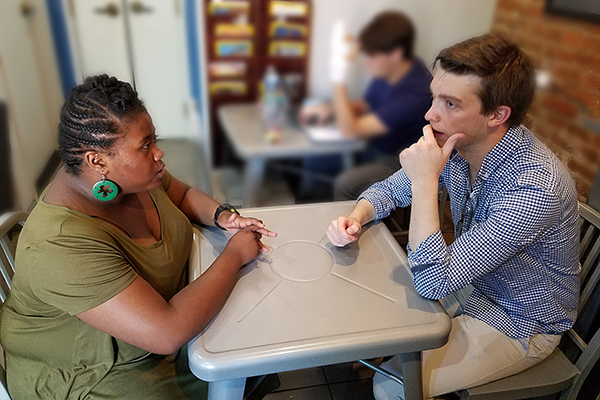Woodworth: Behind the Data — Communities Must Hold School Boards, Authorizers Accountable to Ensure Quality Education

(Photo Credit: Buckner/Getty Images)
The ultimate goal for an education system is to enable individuals to become happy, engaged, productive members of society.
Unfortunately, at this time, measuring happiness, productivity, and civil contribution of individuals is difficult. Tracing those measurements back to the schools attended by an individual is practically impossible. Thus, researchers and other interested individuals must apply available measures to estimate the effectiveness of schools.
One of those available measures is college attendance and graduation. Another measure that is commonly used to estimate school effectiveness is academic growth.
The Center for Research on Educational Outcomes has conducted a series of studies estimating charter effectiveness as measured by impact on academic growth. One of CREDO’s most recent studies examined the impact of charter network organizations on student academic growth. This study contained breakouts by network organizations. These breakouts included many of the networks which are part of The Alumni, and the results from the CREDO study align strongly with The Alumni’s findings in graduation rates.
THE NETWORKS
The KIPP network of schools has produced a strong ninth-grade cohort graduation rate, which exceeds that of students with similar demographic characteristics. Likewise, the KIPP schools had a strong positive impact on student growth. Across the KIPP organization, charter students had the equivalent of 57 additional days of education per school year in math and 46 additional days in reading when compared to students with similar demographic characteristics attending traditional public schools. (A school year is equal to attending traditional public schools for 180 days.)
The Uncommon Schools network was a standout in the graduation numbers with 50 percent of 12th-grade students eventually graduating from college. Likewise, Uncommon Schools network was a standout in CREDO’s estimate of academic growth. In each school year, students who attended an Uncommon school gained 137 days of additional learning (180-day school year + 137 additional days = total of 317 days of learning per year) in math and 86 days of additional learning in reading. Considering CREDO’s earlier study of charter school network effects alongside the current study, Uncommon Schools show strong effects that get even stronger over time. These results are consistent with the improvements in GPA and SAT results reported in the first installment of The Alumni.
The Achievement First network is relatively young in terms of college matriculation, but it has thousands of students currently enrolled in its schools. CREDO included these students in the 2017 study. Achievement First had results which were on par with those of Uncommon Schools: students attending Achievement First schools gained the equivalent of an additional 125 days of learning in math and 57 additional days of learning in reading. These results represent a strong, significant effect for Achievement First’s practices.
CREDO also included the Houston-based YES Prep network in a previous iteration of the study. In both the 2013 and 2017 studies, students attending YES Prep schools had strong positive effects on growth. The findings from the most recent CREDO study show YES Prep students gain the equivalent of an additional 63 days of learning in math and 57 additional days in reading. Again, we see the results from analyses of growth measures aligning with the results of college graduation rates.
The Alumni relies on National Clearinghouse Data to measure the college graduation rate for IDEA Public Schools network, which was reported at 35 percent. This rate is higher than would be expected for students with the demographic profile of IDEA schools’ students. Likewise, the CREDO Charter Management Organization study found stronger than expected growth for the 17,000 charter school students attending IDEA schools. Attending an IDEA charter school resulted in 80 additional days of learning in math and 74 additional days in reading.
The Noble Network of Charter Schools had college graduation rates of 31 percent and CREDO effect sizes of an additional 177 days in math and 108 days in reading. However, these numbers were based on a smaller sample size. The reading effect in particular was not significant.
For Alliance College-Ready Public Schools, the college graduation rate was 25 percent. Consistent with the other networks described above, the Alliance College-Ready Public Schools also had consistent growth effect sizes in the CREDO study. Students attending Alliance schools had growth equivalent to an additional 68 additional days of learning in math and 51 additional days in reading.
The other two networks included in The Alumni were Aspire Public Schools and Green Dot Public Schools. Neither network had academic growth which was significantly different from their comparison students.
Seven of the nine charter school networks included in The Alumni had both graduation rates above what would be expected and academic growth effect sizes which were significantly stronger than their comparisons.
WHAT THE NUMBERS MEAN
As stated above, the ultimate measure of the performance of a school system would be to examine the actual outcomes for students 10, 15, or 25 years down the road. Short of that ability, multiple measures of school effectiveness can be used to estimate the impact of attending a particular school system. While the college graduation rates presented in The Alumni represent a small sample of schools, the strong alignment between the CREDO results and the graduation rates suggests measuring college graduation rates may be a good measure of school impact.
Most important, if the correlations between graduation rates and other measures remain strong, this would provide evidence that other measures of effectiveness can be used as interim estimates of school effectiveness in addition to college graduation rates. This is most important for charter schools that are too new to measure their college graduation rates, much less life outcomes 15 or more years after school enrollment.
The CREDO studies include results for hundreds of networks and thousands of schools across the years. Being able to make a reasonable estimate of the future impact of attending a school without having to wait 20 years is obviously a desirable goal. This is why parents, students, legislators, community members, and everyone else should demand rigorous evaluations of all public schools. Schools — both charter and traditional — should have to demonstrate that they are providing strong outcomes for students. Those schools that fail should be shut down or handed over to more effective leadership.
Ensuring a quality education for all students is the primary responsibility of charter school authorizers and local school boards. And communities must hold authorizers and local school boards responsible. The public should expect multiple measures of academic progress and achievement for their schools. Communities in which schools continually fail students should be up in arms and in the voting booths to ensure responsible leaders at the local and state levels demand an excellent education for all students wherever they may attend school.
James L. Woodworth is a senior research associate at the Center for Research on Education Outcomes at Stanford University. James holds a PhD in Education Policy from the University of Arkansas and Masters and Bachelors degrees in education from Arkansas Tech University. Prior to coming to CREDO, James was a Distinguished Doctoral Fellow in the Department of Education Reform at the University of Arkansas. James worked for 11 years as a public school teacher in Arkansas and spent six years serving in the United States Marine Corps.
Your Alumni
Story Here
We Recommend
-
Noble Network of Charter Schools: It’s Not Just About Going to College, It’s Also About Leaving to Learn Outside Chicago
-
King & Peiser: College Completion — Charter Schools as Laboratories
-
Q&A With UNCF CEO Michael Lomax: We’ve Got to Garner More Resources for Low-Income Kids for This Journey “To and Through” College
-
Gilchrist: My Charter School Saved My Life
-
Exclusive: Data Show Charter School Students Graduating From College at Three to Five Times National Average
-
WATCH: At Newark’s North Star Academy, 100% of the Class of 2017 Is Going to College
-
WATCH – The Alumni Tell Their Stories: College Gave Jadah Quick Upward Mobility
-
The Data Behind The Alumni: Unbundling Facts, Figures, and Caveats











